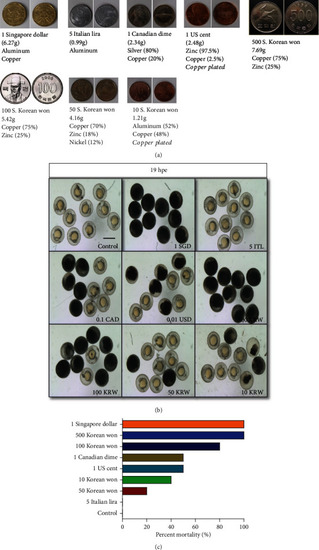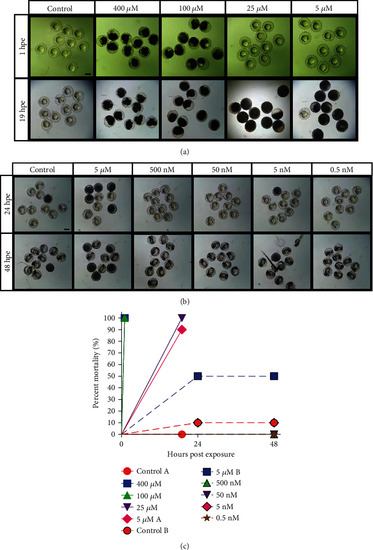- Title
-
The Effects of Copper Constituent of Coin Currency on Embryonic Zebrafish Development
- Authors
- Hong, T.I., Kang, S.G., Lee, Y.R., Choi, T.I., Kim, W.K., Kim, C.H.
- Source
- Full text @ Biomed Res. Int.
|
Effects of various coin currencies on developing zebrafish embryo. (a) Different coin currencies described by country of origin, monetary value, mass, and composition. (b) Comparison of embryo (n = 10) morphology at 19 hpe after addition of coins; hpe: hours post exposure; control: embryos in egg water (no addition); SGD: Singapore dollar; ITL: Italian lira; CAD: Canadian dollar; USD: US dollar; KRW: South Korean won. Scale bar: 200 μm. (c) Quantification of early mortality at 19 hpe, according to group. |
|
Assessment of effects by copper-plated coin. (a) Effects of US 1 cent coin on developing embryos (n = 10) at differential stages of development, indicating time point of exposure to penny: 1-cell (~0.25 hours post fertilization or hpf), sphere (~4 hpf), bud (~10 hpf), 10-somite (~14 hpf); control: embryos in egg water (no addition). (b) Magnification of representative image for relevant stages and time points. Scale bars: 200 μm. (c) Survival curve showing percent mortality at indicated stages and time points. |
|
Effects of copper (II) ion solution on developing zebrafish embryos. (a) Higher concentration range of copper sulfate pentahydrate observed within 24 hours post exposure (hpe) at 1 and 19 hpe. (b) Lower concentration serial dilution of copper sulfate solution observed over a 48 h period at 24 h intervals. Control: embryos in egg water (no copper solution). Concentrations in header indicate the concentration of copper sulfate solution. Scale bars: 200 μm. (c) Aggregate of mortality data quantified from (a) and (b). Repeat labels are differentiated by letter of respective panel. |



